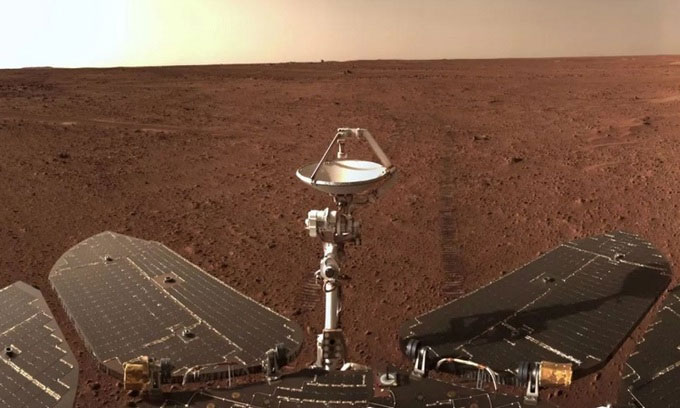Chinese robot takes pictures to celebrate 100 days on Mars
The autonomous robot Chuc Dung sent back a panoramic photo of the surrounding area in the Utopia Planitia plain on Mars.
Engineers are preparing the robot to spend more than a month in safe mode this fall. The solar-powered 6-wheeled self-propelled robot has traveled 1,064 meters since rolling on the surface of the red planet on May 22. But from mid-September to the end of October, Chuc Dung and the orbiting Thien Van 1 spacecraft will enter safe mode because charged particles from the Sun will affect communications with Earth.

Chuc Dung's solar cells and communication equipment appear in the panorama. (Photo: CNSA)
To prepare for a short break, Chuc Dung stopped to observe the surrounding area with a panoramic camera. The returned image shows the robot with a solar panel and antenna near a sand dune that scientists on the mission want Chuc Dung to analyze. Some of the more distant objects are on the horizon of the photo, including the protective shield when the robot lands. Chuc Dung once passed where this part fell in July 2021.
Since landing on May 14 and launching operations a week later, Chuc Dung has rolled south, analyzing a variety of rocks, sand dunes and other features. Tianwen 1 orbits and flies over Zhurong once a day to transmit data to the mission control center in China. The National Astronomical Observatory of China (NAOC) also released images from the Tianwen 1 spacecraft's high-resolution camera, documenting Zhu Rong's journey from the landing station, including the trail of the car's tracks left by the robot. back on the ground.
A new study of geological features in Chuc Dung's landing site identifies many geomorphologies that mission scientists want to understand. According to the research, the robot will look at high ledges created by wind or depressions formed by erosion, especially mysterious recesses. One of the team's main goals was to use Chuc Dung's ground-penetrating radar to determine the thickness and distribution of soil near geomorphology believed to be made of water or subsurface ice. The existence of water has profound implications for researchers understanding the climate history of Mars as well as a potential resource for future manned missions.
Both the robot Chuc Dung and the ship Thien Van 1 will be suspended for about 1.5 months. The two vehicles will automatically conduct a status assessment, self-monitor and repair failures until communication is restored.
- Celebrate the round-robin robot
- The Moot Robot takes a picture of two Martian moons
- Christmas on Mars: ESA publishes beautiful pictures of snow and ice on Red Planet
- NASA postponed the schedule for launching robots to Mars
- Snake robot can go to Mars
- The 'table tennis robot' could become the first resident on Mars
- Chinese robot ready to fight the US robot, Japan
- Russia develops a nuclear power engine that takes people to Mars for 45 days
- Looking at these pictures, can you guess which ones are not made by humans?
- Revealed 'explorer' will go to Mars in 2020
- NASA robots take pictures of Earth and Venus from Mars
- NASA finally found the missing robot on Mars, but they are still not happy
 Announced 3 houses on the Moon and Mars
Announced 3 houses on the Moon and Mars Science proves: Mars also knows 'deflated'
Science proves: Mars also knows 'deflated' Elon Musk announced the price for a Mars trip was 11.6 billion VND, free of charge
Elon Musk announced the price for a Mars trip was 11.6 billion VND, free of charge NASA discovered strange 'gate' on Mars, is the hiding place found?
NASA discovered strange 'gate' on Mars, is the hiding place found?